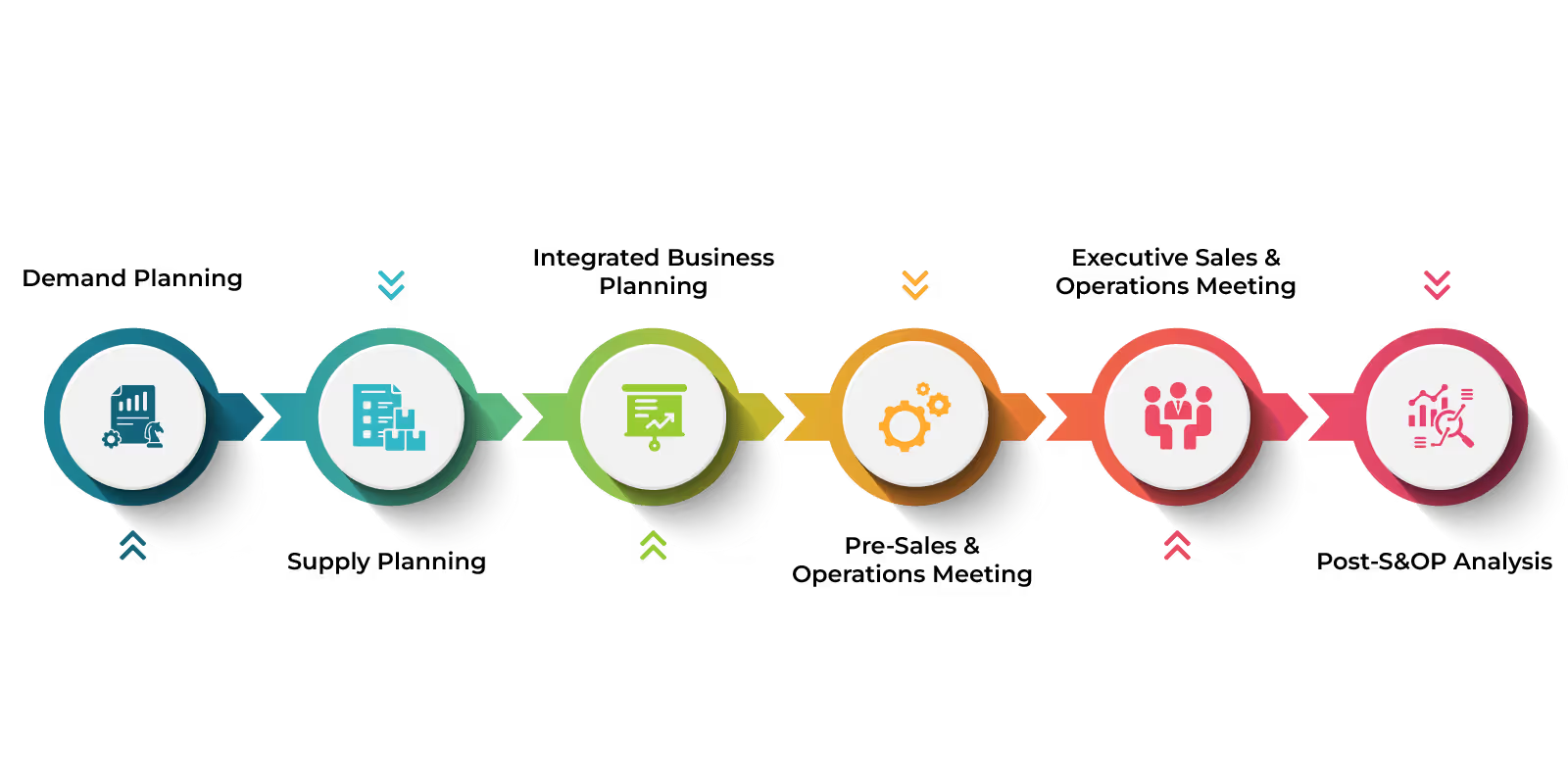
Blog
What are the 6 Key Steps for Sales and Operations Planning?
February 19, 2024


Key Insights
Working in silos is not good for any company. Only when there is constant communication and updates between teams and departments can the organization become dynamic in its growth and success.
Building a plan and structure that can effectively streamline operations across various departments and bring them to a common ground for effective coordination can ensure the overall planning, execution, and achievement of the organizational objective.
Sales and operations planning is one way that companies can align their relevant and crucial departments together to achieve their desired results.
In this article, we will explore sales and operational planning, understanding the 6 key steps to a successful process, and some of the best practices that will help you in optimizing the operations.
So scroll down for more.
What Is Sales And Operations Planning?
Sales and Operations Planning is a strategic management technique where the sales, production, and other operational departments are aligned to balance the demand and supply chain.
Aligning various departments to create a comprehensive supply chain plan helps ensure that the customer demand is met, there is effective use of resources, and that the overall business objective is met. This requires different types of sales planning, which include tactical, operational, and strategic planning, to be integrated seamlessly with supply chain management processes.
6 Key Steps Of The Sales And Operations Planning Process?
The sales and operations planning process follows systematic key steps to align the sales, production, and other strategic teams to achieve the overall business objectives, emphasizing the importance of customer engagement planning. Let us explore these six key steps of the sales and operations planning example.

Demand Planning
Demand planning is the process of estimating product demand through forecasting and data collection. Forecasting involves analyzing historical data, market trends, and other relevant information to calculate the demand. In addition, factors influencing demand can also be determined by collecting data from the sales, marketing, and other relevant departments. The revenue planning process is integral to demand planning, as it involves setting revenue goals, determining the pricing strategy, and identifying potential sources of revenue for the organization.
Supply Planning
Supply planning calculates how the supply based on the forecasted demand can be met. It assesses the production capacity to ensure that labor, machinery, and other resources are available to meet the demand. It also analyzes the current inventory to determine how much production optimization is required to meet demands while ensuring cost-effectiveness.
Integrated Business Planning
Integrated business planning refers to the collaboration between various departments including sales, marketing, finance, production, and other relevant operational departments to ensure all align with the overall business objectives. This integration and collaboration also facilitates easy data sharing that provides a comprehensive view of the business to make informed decisions. A crucial aspect of this process is the inclusion of sales incentive programs, which incentivize sales teams to align their efforts with the broader business goals, ensuring that all aspects of the business work in tandem.
Pre-Sales and Operations Meeting
Pre-sales and operations meetings gather key stakeholders of different departments to identify the gaps and explore the different scenarios that will impact future sales. This helps to analyze the changing market trends and make appropriate measures to grow amidst the change.

Executive Sales and Operations Meeting
The executive sales and operations meeting is when final decision-making happens. The top-level executives are presented with the final resource allocation, production schedules, and financial plans to get approval. It is also a platform where the conflicts between departments are resolved to ensure that the overall organizational objectives are met. Additionally, this meeting serves as an opportunity to evaluate and align individual and departmental goals with organizational objectives, fostering accountability and clarity, which are key advantages of Management by Objectives (MBO).
Post-S&OP Analysis
Implementation of any process must be followed by analysis and feedback. The post-sales and operations analysis evaluates the effectiveness of the S&OP process through established key performance metrics. To ensure continuous improvement, feedback must be gathered to plan the future planning process as well as adapt to the changing market trends.
Following this cyclic process helps organizations to evaluate the efficiency of their operational process, adapt to the changing market trends, and make data-driven decisions for optimized performance.
For further insights, here's a recommended read on approaches of sales planning: Why Sales Approaches Are the Key to Your Business Success
Best Practices For Effective Sales And Operations Planning?
Effective sales and operations planning optimizes your organizational performance by aligning the relevant departments with synchronized goals and strategies, emphasizing the importance of sales team management strategies to enhance overall efficiency.. So here are a few best practices to enhance the effectiveness of your sales and operations planning process.

Executive Leadership Support
Sales and operations planning is the collaboration between various relevant departments. Hence it is important to get the executive leadership support to foster and strengthen the collaborative culture, make strategic decisions, and ensure the smooth functioning of the S&OP process.
Cross-Functional Collaboration
All the departments part of the sales and operations planning must work towards fostering collaboration with other departments. This involves establishing regular communication, easy sharing of data and information, and keeping each other updated about the progress made. A streamlined cross-functional collaboration makes the overall planning process seamless.
Clear Communication
When various departments with their own set of responsibilities and duties collaborate it is necessary to set a clear communication process. This involves setting goals and expectations, establishing performance metrics for evaluation, building a streamlined data-sharing process, and keeping everyone in the loop updated.
Regular Review Meetings
For effective sales and operations planning, all stakeholders must meet regularly to review the progress of work. This helps review the plans, resolve any conflicts, and make decisions that work towards achieving the overall objective.
Performance Metrics
Performance metrics and KPIs are crucial in evaluating the effectiveness of sales and operations planning. This involves tracking the forecasting accuracy, evaluating the inventory levels, and assessing the financial performance, including metrics like ACV in SaaS.. Evaluating the efficiency of the sales and operations planning through sales operations KPIs will help identify strengths and areas of improvement for the coming year.
Technology Utilization
With advancement in all areas of business operations, leveraging planning and analytics tools is inevitable for sales and operations planning. Implementing planning tools reduces the manual work and errors that can happen along with it. It enhances the accuracy of demand forecasting, provides data-driven insights, and facilitates growth.
Continuous Improvement
Sales and operations planning must establish a continuous improvement process that will help enhance their overall performance. This involves regularly assessing the effectiveness of the process, understanding areas of improvement, and making the required changes based on data and feedback.
Building and incorporating these best practices gives structure to your sales and operations planning process and helps enhance the effectiveness and efficiency of the operations.
Benefits of Integrating S&OP with Supply Chain Management:
Integrating sales and operations planning (S&OP) with supply chain management can significantly enhance a company's ability to respond to market demands, optimize resources, and improve overall performance. Here are some key benefits:
- Improved Demand Forecasting: S&OP provides a structured framework for collaborative forecasting, incorporating insights from sales, marketing, and operations. This leads to more accurate demand predictions, reducing stockouts and excess inventory.
- Enhanced Collaboration Across Departments: Integrating S&OP with supply chain management fosters cross-functional collaboration, breaking down silos and aligning goals across departments. This ensures that everyone is working towards a common objective.
- Optimized Inventory Management: By aligning demand forecasts with production plans and inventory levels, companies can optimize inventory management, reducing holding costs and improving inventory turnover.
- Increased Operational Efficiency: S&OP helps streamline operations by coordinating production schedules, resource allocation, and logistics. This leads to increased efficiency and reduced waste.
- Improved Customer Satisfaction: Accurate demand forecasting and optimized inventory management enable companies to meet customer demand on time, improving customer satisfaction and loyalty.
- Better Financial Performance: By optimizing inventory, reducing costs, and improving customer satisfaction, S&OP contributes to better financial performance, including increased profitability and return on investment.
- Enhanced Risk Management: S&OP helps identify and mitigate potential risks in the supply chain, such as supply disruptions, demand fluctuations, and capacity constraints.
- Data-Driven Decision Making: S&OP provides a structured framework for data analysis and decision-making, enabling companies to make informed decisions based on accurate and timely information.
- Scalability and Flexibility: Integrating S&OP with supply chain management enhances scalability and flexibility, enabling companies to adapt to changing market conditions and growth opportunities.
- Better Supplier and Partner Relationships: S&OP allows for increased communication, and shared data with suppliers and partners. This allows for better planning, and stronger relationships.
Final Thought
Sales and operations planning is a strategic approach to bringing all the key stakeholders into business operations to ensure the effective utilization of budget and resources.
With the salesforce predicting the sales that are expected of the financial year, the production team is better prepared to meet the demands, and the operations team keeps the inventory count tally, there is a streamlining of the process that happens.
However, to ensure the effectiveness of the coordination, there are ways to strengthen teamwork, establish clear communication, and review the effectiveness of the process regularly. In addition, the advancements in technological tools have also enhanced sales and operations planning by automating everyday routine tasks and reducing the errors involved.
Regularly taking reviews and evaluating the effectiveness of the process in achieving the overall organizational goal will help in determining the strengths and areas of improvement for future progress.
To read more about these sales-related operations, visit https://www.kennect.io/. For more information, Book A Demo NOW!
ReKennect : Stay ahead of the curve!
Subscribe to our bi-weekly newsletter packed with latest trends and insights on incentives.
Thank you! Your submission has been received!
Oops! Something went wrong while submitting the form.
Your data is in safe hands. Check out our Privacy policy for more info















